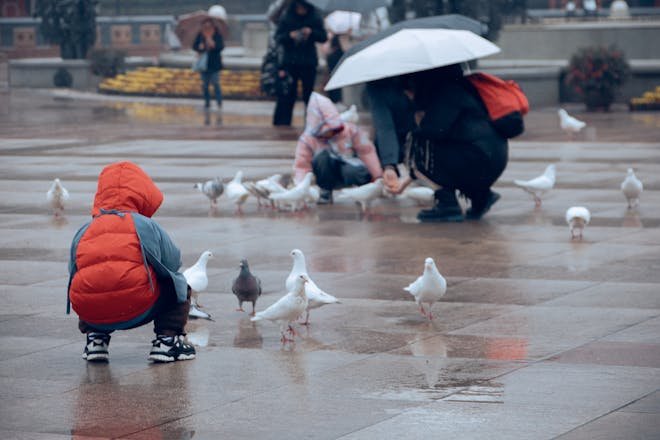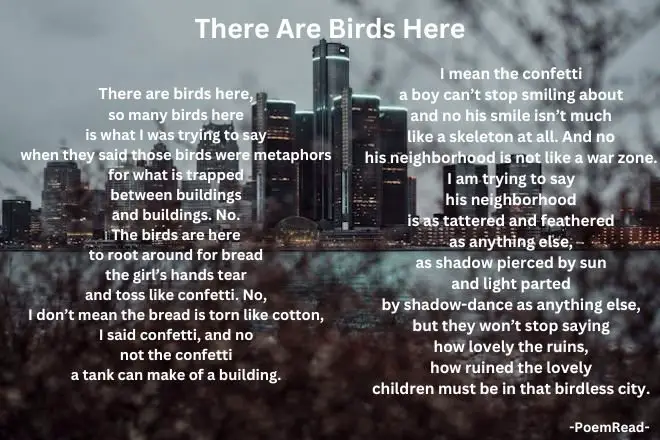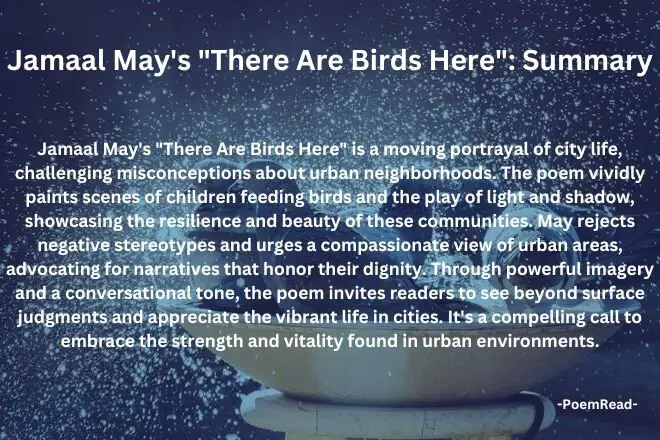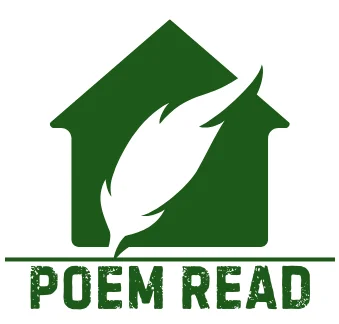
Jamaal May’s “There Are Birds Here” presents a vivid portrayal of urban life while addressing stereotypes about inner-city neighborhoods. The poem uses powerful imagery and precise language to encourage readers to look beyond surface-level judgments and appreciate the beauty and richness of daily life in these communities. This analysis will explore various literary aspects of the poem, including its subject, context, theme, tone, structure, and form, as well as a line-by-line analysis and the literary devices employed by the poet.
There Are Birds Here
There are birds here,
so many birds here
is what I was trying to say
when they said those birds were metaphors
for what is trapped
between buildings
and buildings. No.
The birds are here
to root around for bread
the girl’s hands tear
and toss like confetti. No,
I don’t mean the bread is torn like cotton,
I said confetti, and no
not the confetti
a tank can make of a building.
I mean the confetti
a boy can’t stop smiling about
and no his smile isn’t much
like a skeleton at all. And no
his neighborhood is not like a war zone.
I am trying to say
his neighborhood
is as tattered and feathered
as anything else,
as shadow pierced by sun
and light parted
by shadow-dance as anything else,
but they won’t stop saying
how lovely the ruins,
how ruined the lovely
children must be in that birdless city.
Content
- About the Author: Jamaal May
- Subject of "There Are Birds Here"
- Context of "There Are Birds Here"
- Theme and Tone of "There Are Birds Here"
- Persona, Setting, and Narrative of "There Are Birds Here"
- Form and Structure of "There Are Birds Here"
- Line-by-Line Analysis of "There Are Birds Here"
- Poetic and Literary Devices Used in "There Are Birds Here"
- Implications and Meanings of "There Are Birds Here"
- Interactive Summary
About the Author: Jamaal May
Jamaal May is an award-winning American poet known for his insightful and thought-provoking work. Born and raised in Detroit, Michigan, May often draws on his experiences in urban environments to inform his poetry. His writing frequently addresses themes of identity, community, and resilience.May’s debut collection, “Hum,” received widespread acclaim, and he continues to be a significant voice in contemporary poetry, using his craft to challenge perceptions and highlight the beauty found in unexpected places.
As a significant voice in contemporary poetry, May uses his craft to challenge perceptions and highlight beauty in unexpected places. Born and raised in an urban environment, May’s experiences shape his unique perspective, making his poetry both relatable and captivating. His ability to capture the essence of urban life and infuse it with depth and meaning has earned him recognition as a notable figure in the literary world.
Subject of “There Are Birds Here”
The subject of “There Are Birds Here” revolves around the presence and significance of birds in an urban landscape. Jamaal May uses the birds as a central image to challenge and dismantle negative stereotypes about inner-city neighborhoods. These birds are not merely metaphors for entrapment or desolation; instead, they symbolize the real, tangible life that flourishes in these environments.
May highlights everyday moments, like children feeding birds with torn bread, to showcase simple joys and acts of beauty often overlooked.By emphasizing the birds’ literal presence, May highlights the vibrancy and resilience within these communities. The poem challenges misconceptions that these neighborhoods, often portrayed as lifeless and hopeless, are instead full of life and vitality.
This shift in perspective encourages readers to move beyond clichéd images of urban decay and acknowledge everyday moments of grace and beauty. Through this approach, May offers a more realistic and authentic depiction of inner-city life, countering prevailing narratives of despair and destruction.
Context of “There Are Birds Here”
“There Are Birds Here” unfolds against the contemporary urban landscape of America, specifically drawing from the experiences and perspectives associated with cities like Detroit, where Jamaal May has roots. In the early 21st century, numerous urban areas grappled with substantial challenges, including economic downturns, deindustrialization, and escalating crime rates. These difficulties often resulted in negative portrayals in the media and contributed to pessimistic public perceptions.
These portrayals also tended to depict these areas as hopeless and dangerous, overshadowing the positive aspects and resilient spirit of their inhabitants. Therefore, May’s poem serves as a response to these simplistic narratives, aiming to offer a more nuanced and truthful representation. The poem delves into the broader context of how marginalized communities are depicted and discussed in public conversations.
By highlighting the everyday beauty and joy present in these neighborhoods, May challenges the limited views that fail to capture the complex nature of urban life. This context is vital in grasping the poem’s underlying message, as it shows the disparity between perception and reality. Furthermore, the poem encourages readers to look deeper and appreciate the diverse spectrum of life within these communities.
Theme and Tone of “There Are Birds Here”
Theme
The central theme of “There Are Birds Here” is the resilience and vibrancy of urban communities, particularly those often mischaracterized as desolate or dangerous. Jamaal May challenges the prevailing negative stereotypes about inner-city neighborhoods by presenting them as places full of life, beauty, and hope. The poem emphasizes the importance of seeing beyond superficial judgments to recognize the complexity and richness of these environments.
Through the depiction of birds and children, May highlights everyday moments of joy and innocence that persist despite societal challenges. This theme extends to a broader commentary on how marginalized communities are often misunderstood and unfairly portrayed. The poem advocates for a more compassionate understanding of these communities, acknowledging their struggles. It also celebrates their enduring spirit and vitality.
Tone
The tone of “There Are Birds Here” is both assertive and hopeful. Jamaal May’s repeated use of “No” throughout the poem conveys a strong, almost defiant rejection of negative stereotypes and misconceptions about urban life. This assertiveness is paired with a sense of hopefulness, as the poem consistently highlights moments of beauty and joy. The imagery of birds and children brings a sense of wonder and celebration, standing in stark contrast to the often bleak portrayals linked with inner-city neighborhoods.
May’s tone suggests a deep respect and affection for these communities, and a desire to change the narrative surrounding them. The poem’s tone ultimately encourages readers to adopt a more empathetic and open-minded perspective, recognizing the inherent worth and potential in places and people frequently overlooked or dismissed.
Persona, Setting, and Narrative of “There Are Birds Here”

Persona
The persona in “There Are Birds Here” is a speaker deeply familiar with the urban environment they describe. This voice is empathetic, assertive, and somewhat frustrated as they attempt to correct the misconceptions held by outsiders about their community.
The speaker’s intimate knowledge and personal investment in the neighborhood suggest they are either residents or someone who has spent significant time there. This offers an insider’s perspective that is both authentic and authoritative. The repetition of “No” throughout the poem emphasizes the speaker’s determination to counteract negative stereotypes and defend the true nature of their environment.
Setting
The setting of the poem is a vibrant urban neighborhood, characterized by its density and the presence of both human and natural life. May paints this setting with images of children feeding birds, torn bread tossed like confetti, and the interplay of light and shadow. These details create a rich, textured backdrop that highlights the everyday beauty often overlooked in urban environments.
The setting is not named specifically, allowing it to stand in for many urban areas that face similar misconceptions. This anonymity helps universalize the poem’s themes, making the setting relatable to various readers who might recognize the dynamics at play in their own cities.
Narrative
The narrative of “There Are Birds Here” progresses through a series of corrections and clarifications. Initially, the speaker affirms the actual presence of birds, contradicting the metaphorical interpretations imposed by outsiders. The narrative structure is conversational, resembling a response to an ongoing dialogue or a sequence of misconceptions articulated by an unseen interlocutor.
The poem’s progression reveals the speaker’s frustration with these misinterpretations, as they repeatedly assert the true nature of their neighborhood. By describing scenes of children feeding birds and the dynamic play of light and shadow, the speaker builds a vivid, positive image of the urban environment.
The narrative culminates in a powerful rejection of the idea that the neighborhood is a war zone or a place of entrapment. Instead, it highlights its beauty, complexity, and resilience. Overall, the narrative is one of reclamation and affirmation. The speaker seeks to redefine their neighborhood in the eyes of the reader, moving away from negative stereotypes to a more nuanced, appreciative understanding.
Through this narrative, May invites readers to reconsider their own perceptions. He urges them to recognize the everyday vibrancy and strength inherent in urban communities.
Form and Structure of “There Are Birds Here”
Form
“There Are Birds Here” by Jamaal May is written in free verse, meaning it does not follow a specific rhyme scheme or consistent meter. This form allows May to convey his message in a natural and conversational manner, reflecting the fluidity and unpredictability of urban life.
Free verse is particularly effective for this poem because it mirrors the spontaneity and authenticity of the scenes May describes, such as children feeding birds and the everyday interactions within the neighborhood. This approach enhances the poem’s ability to capture the real, unstructured beauty of the urban environment.
Structure
The poem consists of a single stanza of 32 lines. The lack of stanza breaks contributes to a continuous flow of thought, enhancing the conversational tone and making the poem feel like a direct address to the reader. This unbroken structure also mirrors the seamless integration of life’s various aspects in an urban setting, where beauty and struggle coexist without clear boundaries.
Line Breaks and Punctuation
May uses enjambment extensively, allowing sentences and phrases to flow over line breaks without punctuation. This technique creates a sense of movement and urgency. It compels the reader to move quickly from one line to the next, much like the dynamic energy of city life. Additionally, the enjambment emphasizes certain words and phrases, adding layers of meaning and encouraging deeper reflection on the imagery and messages conveyed.
For example, the line break between “confetti” and “a tank can make of a building” draws attention to the stark contrast between joyful celebration and violent destruction. This highlights the poet’s intent to redefine how we perceive inner-city neighborhoods.
Punctuation
The poem features minimal punctuation, primarily relying on line breaks and natural pauses to guide the reader. This sparse punctuation enhances the poem’s conversational tone, making it feel as though the speaker is engaging in an impassioned dialogue with the reader. Additionally, the repeated use of the word “No” acts as a form of punctuation. This emphasizes the speaker’s rejection of negative stereotypes and misconceptions.
Rhyme and Rhythm
Although the poem doesn’t have a traditional rhyme scheme, the natural cadence of spoken language and the thoughtful placement of words and phrases influence its rhythm. The repetition of certain words and phrases, such as “No” and “confetti,” creates a rhythmic pattern. This repetition reinforces the poem’s themes and adds to its musicality.
Meter
“While “There Are Birds Here” is written in free verse, you can still detect elements of meter in its natural speech patterns. The poem doesn’t strictly follow a metrical pattern like iambic pentameter, but it does have a rhythmic quality due to its varied line lengths and strategic stresses.
For instance, the repeated use of the word “No” at the start of several lines creates a rhythmic emphasis, similar to a metrical foot, that punctuates the poem’s assertions. This rhythm emphasizes the poet’s rejection of negative stereotypes and enhances the overall flow of the poem.
The choice of free verse and the deliberate structure of the poem reflect May’s intention to present a raw, unfiltered portrayal of urban life. The form and structure of “There Are Birds Here” contribute to its powerful impact, drawing readers into a deeper understanding of the beauty and resilience that characterize inner-city communities.”
Line-by-Line Analysis of “There Are Birds Here”
Lines 1-2
“There are birds here, / so many birds here”
The poem starts by directly stating the existence of birds. Jamaal May reinforces this fact by repeating “birds here,” highlighting their abundance and reality. This counters any assumptions that urban areas are devoid of life. The repetition of “here” stresses the urgency and significance of acknowledging life’s actual presence in these settings.
Lines 3-5
“is what I was trying to say / when they said those birds were metaphors / for what is trapped”
May’s poem uncovers a misinterpretation of his intended message, as others perceive the birds as metaphors for entrapment. This misunderstanding underscores a prevalent inclination to assign negative symbolism to urban environments. It reflects a larger societal bias that overlooks the straightforward, inherent beauty found in these communities.
Lines 6-8
“between buildings / and buildings. No. / The birds are here”
The phrase “between buildings and buildings” depicts the dense and sometimes claustrophobic urban landscapes. Yet, May dismisses the notion that the birds represent entrapment within these spaces. The emphatic “No” and the reaffirmation that “The birds are here” demand recognition of the birds as actual, living creatures, rather than mere symbols of confinement.
Lines 9-11
“to root around for bread / the girl’s hands tear / and toss like confetti.”
May paints a vibrant picture of a girl feeding birds, bringing forth a vivid and joyous image. The comparison of torn bread to confetti adds a celebratory tone to the scene, evoking a moment of pure happiness and festivity. This imagery stands in contrast to the gloomy and dismal portrayals of urban life, presenting instead a scene filled with innocent joy and pleasure.
Lines 12-14
“No, / I don’t mean the bread is torn like cotton, / I said confetti, and no”
The poet anticipates a potential misinterpretation of his imagery. By specifying “confetti” instead of “cotton,” May emphasizes the celebratory essence of the scene. This insistence on accuracy reflects his desire for a positive portrayal of his neighborhood. The repetitive use of “No” highlights his frustration with ongoing misinterpretations.
Lines 15-17
“not the confetti / a tank can make of a building. / I mean the confetti”
May contrasts the joyful image of confetti with the destructive image of a tank reducing a building to rubble. This stark juxtaposition highlights the poet’s intent to focus on positive, life-affirming imagery rather than destructive, violent associations. The confetti here is a symbol of celebration, not destruction.
Lines 18-20
“a boy can’t stop smiling about / and no his smile isn’t much / like a skeleton at all. And no”
The image of a smiling boy is employed to express genuine happiness. By rejecting the comparison of his smile to a skeleton, May dismisses the morbid and death-related imagery commonly linked with urban life. He emphasizes the authentic and untainted joy present in these neighborhoods, challenging grim stereotypes in the process.
Lines 21-23
“his neighborhood is not like a war zone. / I am trying to say / his neighborhood”
May directly addresses and rejects the frequent comparison of inner-city neighborhoods to war zones. He emphasizes the significance of perceiving these areas for what they genuinely are, rather than through the lens of violence and devastation often imposed by outsiders.
Lines 24-26
“is as tattered and feathered / as anything else, / as shadow pierced by sun”
The imagery here is rich and layered. The neighborhood’s “tattered and feathered” description suggests a complex beauty characterized by wear and tenacity. The phrase “shadow pierced by sun” creates an interplay of light and darkness, symbolizing hope and beauty amidst adversity. This line emphasizes the nuanced reality of urban life, full of contrasts and depth.
Lines 27-28
“and light parted / by shadow-dance as anything else,”
Continuing the theme of complexity, May describes the neighborhood with imagery of light and shadow in dynamic interaction. The “shadow-dance” suggests movement and vitality, reinforcing the idea that these communities are alive and constantly evolving. This imagery challenges static, one-dimensional portrayals of urban areas.
Lines 29-32
“but they won’t stop saying / how lovely the ruins, / how ruined the lovely / children must be in that birdless city.”
In the closing lines, May confronts the enduring negative perceptions held by outsiders. The contrast between “lovely ruins” and “ruined lovely children” underscores the harmful impact of these stereotypes. The phrase “birdless city” acts as a potent metaphor for the wrongful belief that these neighborhoods lack life and joy. May’s final statement emphasizes the importance of rejecting these misconceptions and acknowledging the genuine vitality that exists within urban communities.
Poetic and Literary Devices Used in “There Are Birds Here”

Jamaal May’s “There Are Birds Here” is rich with poetic and literary devices that enhance the depth and impact of the poem. Below, we explore the key devices May employs to convey his themes and messages effectively.
Imagery
May uses vivid imagery to paint a picture of urban life that is full of beauty and joy, countering negative stereotypes. For example:
- “the girl’s hands tear / and toss like confetti”: This image of a girl feeding birds with torn bread, compared to confetti, evokes a sense of celebration and innocence.
- “as shadow pierced by sun”: This imagery suggests hope and resilience, highlighting the interplay of light and darkness in the neighborhood.
Repetition
Repetition is a powerful device in this poem, used to emphasize key points and reinforce the poem’s themes.
- “No”: The repeated use of “No” serves to reject negative interpretations and stereotypes. Each “No” strengthens the poet’s argument against these misconceptions.
- “confetti”: The word is repeated to draw a clear contrast between the joyful image of confetti and the destructive imagery associated with tanks.
Juxtaposition
May frequently places contrasting images and ideas next to each other to highlight differences and challenge perceptions.
- “confetti a tank can make of a building” vs. “confetti a boy can’t stop smiling about”: This juxtaposition contrasts destruction with innocent joy.
- “how lovely the ruins” vs. “how ruined the lovely / children”: This contrast underscores the damaging effects of negative stereotypes on the perception of urban life.
Enjambment
The use of enjambment, where sentences and phrases flow over line breaks, creates a sense of movement and urgency.
- “is what I was trying to say / when they said those birds were metaphors / for what is trapped”: Enjambment here mimics the continuous flow of thought and the ongoing nature of the poet’s argument.
Metaphor and Simile
May uses metaphors and similes to deepen the reader’s understanding and to make complex ideas more relatable.
- “toss like confetti”: This simile compares the torn bread to confetti, suggesting celebration.
- “shadow pierced by sun”: This metaphor conveys the idea of hope and light breaking through darkness.
Tone and Mood
The tone of the poem is assertive and hopeful, conveyed through word choice and sentence structure.
- “No”: The assertive tone of the repeated “No” conveys determination and frustration with misinterpretations.
- “his neighborhood / is as tattered and feathered / as anything else”: The mood here is one of resilience and complexity, challenging one-dimensional views of urban areas.
Symbolism
Symbolism is used to imbue the poem with deeper meaning and to connect with broader themes.
- Birds: The birds symbolize life, freedom, and beauty within the urban environment. They serve as a counterpoint to negative stereotypes.
- Confetti: The confetti symbolizes celebration and joy, contrasting with images of destruction.
Irony
There is a subtle use of irony in the poem, particularly in how others perceive the urban environment versus its reality.
- “how lovely the ruins, / how ruined the lovely / children”: This ironic observation highlights the disconnect between external perceptions and the lived reality of urban residents.
Alliteration and Assonance
May uses sound devices to enhance the musical quality of the poem and to draw attention to specific lines and phrases.
- “shadow pierced by sun”: The sibilance in this line (repetition of the ‘s’ sound) creates a soft, soothing effect, reinforcing the image of light breaking through darkness.
Personification
May subtly personifies the urban environment to highlight its liveliness.
- “as shadow pierced by sun / and light parted / by shadow-dance”: The personification of light and shadow dancing suggests a dynamic, living environment.
Implications and Meanings of “There Are Birds Here”
Implications
Challenging Stereotypes
The poem has important implications for how we view urban areas, especially those where marginalized communities live. May’s emphasis on the actual presence of birds and the everyday happiness in these neighborhoods challenges common negative stereotypes. By rejecting these harmful views, May prompts readers to rethink their assumptions and appreciate the richness and energy of city life.
Representation and Misrepresentation
The poem highlights the dangers of misrepresentation and the importance of seeing communities as they truly are. May’s repeated rejections (“No”) of false metaphors and negative comparisons emphasize the need for accurate and empathetic portrayals. This theme extends beyond the poem, carrying broader societal implications. It urges a more nuanced and respectful approach to discussing and depicting marginalized groups.
Resilience and Beauty
The poem’s imagery and tone celebrate the resilience and beauty found in everyday moments within these communities. By focusing on scenes like a girl feeding birds or a boy’s genuine smile, May emphasizes that joy and life persist despite adversity. This celebration of resilience serves as a powerful counter-narrative to the often-one-dimensional portrayals of inner-city neighborhoods as sites of only decay and despair.
Meanings
Literal vs. Metaphorical
A central meaning in the poem is the tension between literal and metaphorical interpretations. To counteract the metaphorical imprisonment that external observers have imposed, May insists on the literal presence of birds. By doing so, he highlights the importance of recognizing the actual, lived experiences of urban residents. This insistence on literal interpretation becomes a metaphor itself, emphasizing the need to see and value the real lives in these communities rather than reducing them to mere symbols of societal issues.
The Power of Everyday Moments
The poem elevates everyday moments and simple acts of kindness and joy, suggesting that these are the true markers of a community’s vitality. The imagery of bread being tossed like confetti and a boy’s smile represents a celebration of life’s small pleasures. These moments are often overlooked but are deeply significant. By highlighting these simple joys, May underscores the richness and resilience that define urban life.
Redefining Urban Spaces
May’s work implies a need to redefine how urban spaces are viewed and valued. By highlighting the presence of birds and moments of joy, the poem calls for a recognition of these spaces as places of life and potential, rather than just sites of decay and violence. This redefinition has broader implications for policy, community support, and societal attitudes towards urban environments. It encourages a shift towards appreciating the vibrancy and resilience present in these communities. This shift can ultimately lead to more positive and effective approaches in addressing urban challenges.
Interactive Summary

In ‘There Are Birds Here,’ Jamaal May masterfully challenges stereotypes and misconceptions about urban neighborhoods. He does this by highlighting the literal presence of birds and the simple, joyous moments of everyday life. Through vivid imagery and a conversational tone, May brings scenes of children feeding birds and the dynamic interplay of light and shadow in the city to life, emphasizing the beauty and resilience found within these environments.
By repeatedly correcting misinterpretations and rejecting negative metaphors, the poem insists on a more compassionate and nuanced understanding of urban communities. The birds symbolize freedom and life, countering the idea that cities are merely sites of entrapment and decay. May’s use of poetic devices such as repetition, juxtaposition, and enjambment enhances the poem’s impact, urging readers to see beyond superficial judgments and appreciate the inherent worth and vitality of these neighborhoods.
Ultimately, ‘There Are Birds Here’ is a powerful call to recognize the everyday beauty and strength of urban life. It advocates for narratives that honor the dignity and humanity of those who live there. As you reflect on the poem, consider how societal narratives might shape your perceptions of urban areas and how embracing a more empathetic viewpoint can reveal the true vibrancy of these communities.
If “There Are Birds Here” captured your interest, dive into our analysis of Langston Hughes’ “Harlem” for a captivating exploration of urban life’s complexities and societal reflections. Discover the vibrant parallels between these insightful poems and unlock a deeper understanding of urban resilience and beauty.
RELATED POSTS
View all



